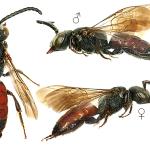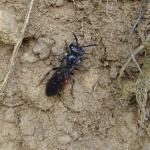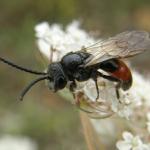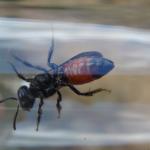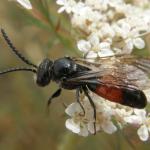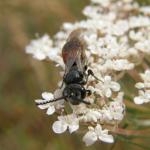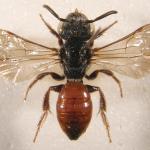Apis glabra FÜESSLY 1775; Andrena ferruginea OLIVIER 1789; Apis gibbosa CHRIST 1791; Melitta picea KIRBY 1802; Melitta sphecoides KIRBY 1802; Andrena austriaca FABRICIUS 1804, nec Panzer 1798; Dichroa analis ILLIGER 1806; Sphecodes apicatus SMITH 1853; Sphecodes nigripennis MORAWITZ 1876; Sphecodes sutor NURSE 1903; Sphecodes nippon MEYER 1922; Sphecodes castilianus BLÜTHGEN 1924; Sphecodes lustrans COCKERELL 1931; Sphecodes pergibbus BLÜTHGEN 1938
One of the larger British halictine bees with a body length in the region of 10mm. In common with most other bees of the genus Sphecodes it is black and red in general appearance. The red tends to be rather darker than in many other species and the wings are strongly infused with black, giving a very distinctive smoky appearance.
Widely distributed through Britain to southern Scotland, but not known from Ireland. It is rarely abundant at any one locality, but may be present in a wide variety of habitats. The species occurs throughout the Palaearctic region.
This bee is not regarded as being scarce or threatened.
Often flying over banks with exposures of bare ground as it searches for host nests. There seem to be no other habitat indicators for this species.
Females may be found between April and September, males between July and September. Early season females are searching for host nests, late season ones are searching for mates or overwintering sites.
The larvae are cleptoparasitic on larger bees of the genera Halictus and Lasioglossum. An adult female Sphecodes bee enters the burrow of a host bee and searches out an almost completed cell of the host where it lays its egg. Some female Sphecodes are apparently unique among cleptoparasitic bees in that they remove (eat?) the host egg before laying their own (see, for example, Stephen, Bohart & Torchio, 1969). New adult Sphecodes emerge toward the end of the flight season.
The bee may be found visiting a wide range of flower species but is probably most often found at those of the Asteraceae and Apiaceae.
None known.
Profile written:
Proofed: January 2012


